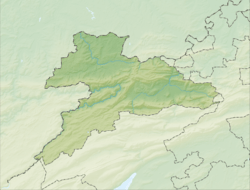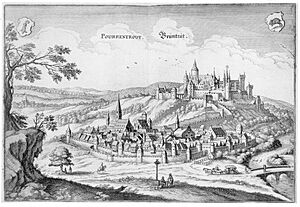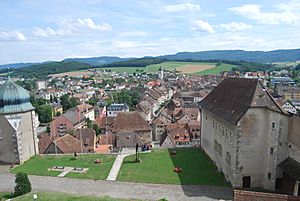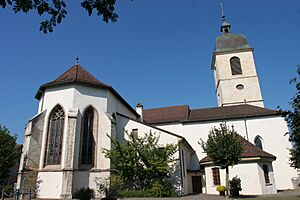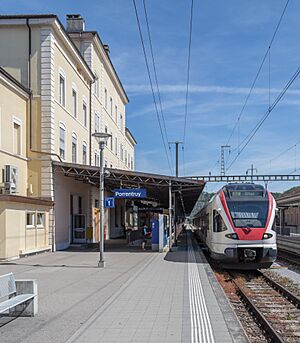Porrentruy facts for kids
Quick facts for kids
Porrentruy
|
||
|---|---|---|
 |
||
|
||
| Country | Switzerland | |
| Canton | Jura | |
| District | Porrentruy | |
| Area | ||
| • Total | 14.76 km2 (5.70 sq mi) | |
| Elevation | 443 m (1,453 ft) | |
| Population
(Dec 2020 )
|
||
| • Total | 6,434 | |
| • Density | 435.91/km2 (1,129.0/sq mi) | |
| Postal code |
2900
|
|
| Surrounded by | Fontenais, Bressaucourt, Courtedoux, Bure, Courchavon, Coeuve, Alle, Courgenay | |
Porrentruy (pronounced poh-rahn-troo-ee) is a town in Switzerland. It's located in the Jura canton and is the main town of its district.
The town's name, Porrentruy, comes from French words meaning "wild boar" (Porc) and "sow" (Truie). You can see this connection in a statue in front of the town hall. The story says the first mayor, whose father was a wild boar, chose the name. He wanted to honor his father's strength and courage.
Porrentruy is also home to HC Ajoie, a professional ice hockey team that plays in Switzerland's top league.
Contents
- History of Porrentruy: A Journey Through Time
- Culture and Heritage: Celebrating History
- Geography: Where Porrentruy Is Located
- Coat of Arms: The Boar Symbol
- Demographics: Who Lives in Porrentruy
- Economy: How Porrentruy Works
- Religion: Faith in Porrentruy
- Education: Learning in Porrentruy
- Transportation: Getting Around Porrentruy
- Notable People: Famous Faces from Porrentruy
- Images for kids
- See also
History of Porrentruy: A Journey Through Time
Ancient Roots: Early Settlements
The first signs of people living in Porrentruy date back to the Stone Age. Tools from the Mesolithic period (Middle Stone Age) have been found here. Later, during the Roman era, a settlement grew. In 1983, parts of a Roman temple were discovered in a cemetery. Roman coins were also found nearby.
Medieval Beginnings: Castles and Bishops
The town's name, Purrentru, first appeared in records in 1136. It might come from a Latin phrase meaning "Ragentrud's bridge." Ragentrud was the wife of a Frankish king. The German name, Pruntrut, might mean "abundant spring."
The first village was built around 1140 near the Saint-Germain Church. The Counts of Pfirt, who owned this area, built a castle on a hill. This castle became the capital of the Ajoie region. A town wall was likely built before 1283 to protect the growing settlements.
Changing Hands: From Counts to Bishops
In 1236, the Counts of Pfirt gave the town to the Counts of Montbéliard. But in 1281, they sold the Ajoie region to the Bishop of Basel. The Counts of Montbéliard didn't want to give up Porrentruy. This led to a siege by King Rudolph I of Habsburg's army. After six weeks, the Count gave in, and Porrentruy became part of the Bishop's lands. In 1283, the king made Porrentruy a free Imperial city.
Golden Age and Challenges: The Reformation and Wars
Because of money problems, the Bishop had to sell Ajoie back to the Montbéliard lords in 1386. But by 1461, it was back under the Bishop's control. When the Protestant Reformation happened in Basel, the Bishop moved his main office to Porrentruy in 1527.
Under Bishop Jakob Christoph Blarer von Wartensee (1575-1608), Porrentruy became very important. Many new buildings were constructed, including the castle and a Jesuit college. This good time ended in 1618 when the Thirty Years' War began. Porrentruy was attacked and robbed many times during this war.
Religious Buildings: Churches and Colleges
The first Saint-Germain church was replaced in the 13th century. The Saint-Pierre Church was finished in 1349. Many religious groups came to the city, like the Jesuits who built their college in 1591. Other groups included the Ursulines and Capuchins.
French Revolution and Swiss Identity
In 1792, French revolutionary soldiers took over Porrentruy and forced the Bishop out. Porrentruy became the capital of a new republic, which then joined France in 1793. After Napoleon's defeat in 1813, the town's future was unclear. In 1815, Porrentruy became part of the Canton of Bern in Switzerland.
Modern Times: Growth and New Canton
In the 19th century, politics in Porrentruy were often about arguments between Liberals and Catholics. The Liberals gained power in 1860.
On April 24, 1917, during World War I, German artillery accidentally shelled Porrentruy. About 20 shells hit the town, damaging buildings and killing at least two people. Germany was targeting military positions nearby but hit neutral Swiss land by mistake. Switzerland protested this violation of its neutrality.
Until World War I, Porrentruy was the main cultural center of the region. But as cars became more common, its location on the edge of the country made it less important. In the late 20th century, French-speaking people in Bern wanted their own canton. This led to the creation of the new Canton of Jura on January 1, 1979. However, Delémont, not Porrentruy, was chosen as the new capital.
Culture and Heritage: Celebrating History
Porrentruy is home to important institutions for the Jura canton, like the cantonal courts. It also has the old archives of the Bishopric of Basel. The town was given the Wakker Prize in 1988 for taking good care of its old buildings.
Historic Buildings and Landmarks
The old town center is beautiful, with many buildings in Gothic, Baroque, and Neo-classical styles. The Jesuit college buildings are now used as a cantonal school. The only remaining medieval city gate is the Porte de France, built in 1563.
The Catholic Church of Saint-Pierre is a Gothic church built between 1330 and 1350. It has valuable old items and a late-Gothic altar. The Catholic Church of Saint-Germain was built in the 13th century. The Jesuit college chapel (1599–1603) has an octagonal tower.
The Château de Porrentruy stands on a hill. It was where the Bishop of Basel lived from 1527 to 1792. The oldest part of the castle is a round tower built in 1271.
Other important Baroque buildings include the Hôtel de Ville (town hall, 1761–63) and the Hôtel-Dieu (1761–65). You can also find beautiful fountains in the old city squares, like the Fontaine des Samarites (1564).
Geography: Where Porrentruy Is Located
Porrentruy is located on both sides of the Allaine River. It's in a region called Ajoie, which is a part of Switzerland that extends into France. The town sits at the foot of the Jura Mountains in the north.
About 34% of the land is used for farming, and 40% is covered by forests. Around 25% of the area has buildings or roads. A small part is rivers or lakes. The highest point in the municipality is about 580 meters (1,900 feet) high.
Coat of Arms: The Boar Symbol
The town's coat of arms shows a black wild boar standing on a silver background. This symbol connects to the town's name and its legendary first mayor.
Demographics: Who Lives in Porrentruy
Porrentruy has a population of about 6,593 people. Around 16% of the people living here are foreign nationals. Most people in Porrentruy speak French as their main language (about 89%). German and Italian are also spoken by smaller groups.
About 22% of the population are children and teenagers (0–19 years old). Adults (20–64 years old) make up about 59.5%, and seniors (over 64 years old) are about 18.5%. In 2000, there were about 3,022 households in the town, with an average of 2.1 people per household.
The historical population is given in the following chart:

Economy: How Porrentruy Works
In the 19th century, Porrentruy changed from a trading town to an important industrial center. It became known for making watches, shoes, and textiles. Later, other industries like metalworking, machine building, electronics, and furniture making grew. Farming is not a big part of the town's economy anymore.
In 2008, there were 48 people working in farming. About 1,933 people worked in factories and construction. The largest number, 3,734 people, worked in services like sales, transportation, hotels, education, and healthcare. Many people travel into Porrentruy for work each day.
Religion: Faith in Porrentruy
According to a 2000 survey, most people in Porrentruy (about 74%) are Roman Catholic. About 9.7% belong to the Swiss Reformed Church. Smaller groups are members of other Christian churches, Islam, Buddhism, and Hinduism. About 7% of the population do not belong to any church.
Education: Learning in Porrentruy
In Porrentruy, about 31% of the population has finished high school. About 12% have gone on to higher education, like university.
The school system in the Canton of Jura starts with two years of optional kindergarten. Then, students go to six years of primary school. After that, there are three years of lower secondary school, where students are grouped by their abilities. After lower secondary, students can go to a three or four-year high school or start an apprenticeship.
In the 2009–10 school year, there were 1,183 students in Porrentruy. This included 83 kindergarten students, 342 primary students, and 758 lower secondary students. Porrentruy is also home to the Bibliothèque cantonale jurassienne, a cantonal library with over 115,000 books.
Porrentruy has the only two high schools (called "Lycées" in French) in the Canton of Jura. One is a public school, and the other is a private school called Collège et Lycée Saint-Charles.
Transportation: Getting Around Porrentruy
Porrentruy is an important hub for trains. It sits where two railway lines meet: one connecting to Delle in France and another connecting to the rest of the Swiss railway network. The first train line opened in 1872.
The town is also on the A16 motorway, which connects to Delémont and Belfort, France. This motorway helps people travel easily, but the railway was very important for the town's growth in the past because it followed the Allaine river.
Notable People: Famous Faces from Porrentruy
- Paul Migy (1814–1879): A Swiss politician who was president of important councils.
- Hélène Rivier (1902–1986): A Swiss librarian who started Switzerland's first free lending library.
- Florian Froehlich (born 1959): A modern artist who creates paintings and sculptures.
- Bernard Comment (born 1960): A Swiss writer and publisher.
- Régis Fuchs (born 1970): A Swiss professional ice hockey player.
- Benjamin Conz (born 1991): A Swiss professional ice hockey goalie.
Images for kids
-
Church and College of the Jesuits
See also
 In Spanish: Porrentruy para niños
In Spanish: Porrentruy para niños




